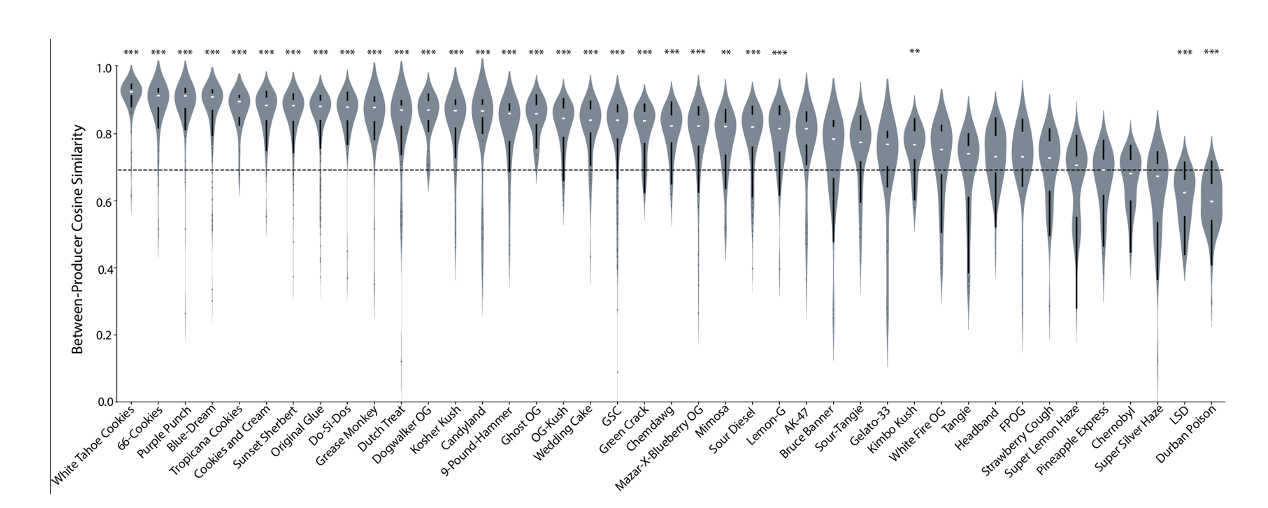by Christiana J. Smith, Daniela Vergara, Brian Keegan, and Nick Jikomes
PLoS One
May 19, 2022
Why this article matters:
Commercial “strain names” are associated with variable levels of chemical consistency. The authors found limited differences between “Indica” and “Sativa,” with some strains showing more chemical variability than others and having unknown entourage effects. Moreover, commercial labels do not accurately represent the chemical makeup of the products.
Summary:
The study titled “The phytochemical diversity of commercial Cannabis in the United States” by Christiana J. Smith, Daniela Vergara, Brian Keegan, and Nick Jikomes, published in PLoS ONE, delves into the chemical diversity of commercial Cannabis products in the United States. The researchers analyzed the cannabinoid and terpene content of commercial Cannabis samples from six US states. They found distinct chemical phenotypes which are consistently present across the samples.
Cannabis contains dozens of chemical compounds with potential psychoactive or medicinal effects. The legal Cannabis industry often markets products to consumers based on labeling systems that are supposed to predict the effects of different “strains.” However, the study found that these commercial composition labels do not consistently align with the observed chemical diversity. In other words, the labels attached to Cannabis-derived product samples do not always accurately represent the chemical makeup of the products.
Despite this, the researchers found that certain testing lab labels show a biased association with specific chemotypes. This means that some labels are more likely to be associated with certain chemical profiles than others. These findings have significant implications for several areas. They affect the classification of commercial Cannabis, the design of animal and human research studies, and the regulation of consumer marketing. These areas are often disconnected from the actual chemical reality of the Cannabis-derived material they aim to represent.

To quantify the phytochemical similarity of products sharing a common strain name, the authors plotted the distribution of product similarity scores sorted left to right from highest to lowest mean similarity for the 41 strains used in this analysis. The violin plot depicts the degree and range of similarity by strain. White Tahoe Cookies is similar across regions whereas Durban Poison is highly variable. **P < 0.001, ***P < 0.0001, Welch’s test.
The researchers also found that the majority of the variance in the cannabinoid profiles of the samples was explained by variation among the three most abundant cannabinoids: THC, CBD, and CBG. They also found that most samples contained low levels of cannabinoids beyond THC, but a small percentage of samples had total CBD or total CBG of 1% by weight or higher.
In addition to cannabinoids, Cannabis also contains a diverse class of related compounds known as terpenes. The researchers found that on average, the terpenes myrcene, β-caryophyllene, and limonene were present at the highest and most varied levels in the samples. They also found that total terpene content averaged 2% by weight and displayed a modest but robust positive correlation with total cannabinoid content.
The study is the largest chemotaxonomic analysis of commercial Cannabis-derived flower to date, with a sample size of 89,923. The samples were submitted by cultivators for testing in order to comply with state laws, representing Cannabis-derived products destined for sale in retail locations within each state.
The researchers concluded that their results provide new possibilities for systematically categorizing commercial Cannabis based on chemistry. This could inform the design of preclinical and clinical research experiments and the regulation of commercial Cannabis marketing.
* Smith CJ, Vergara D, Keegan B, Jikomes N. “The phytochemical diversity of commercial Cannabis in the United States”. PLoS One. 2022 May 19;17(5):e0267498. doi: 10.1371/journal.pone.0267498. PMID: 35588111; PMCID: PMC9119530.

